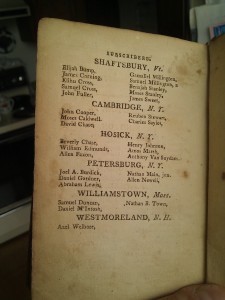I’m reading up on the Society of United Christian Friends, an early branch of Univeralism and native to New York. It was founded in 1796 in New York City when three class leaders from the now-venerable John Street Methodist Church withdrew (before being expelled) for their Universalism. But this left them churchless and pastorless. From The Christian Universalist:
Thus situated, belonging to no church, we seriously considered what was our duty, as professors of religion, on the subject of worship. We knew that we could read the Scriptures together, pray to God for each other, sing the praise of God, our Saviour, and be helpers to each other in our common faith. We therefore determined to worship together, hoping for the enjoyment of the promise of Christ, that where two or three are gathered together in his name, he would be with them.
As it is necessary that wherever men associate for any permanent purpose, they should distinctly understand by what rules they would govern themselves in their associate character, so we thought it best to draw up these rules; and while we were engaged in this work, sundry persons who had previously belonged to the Methodist Society, and who, with us, hoped for the final happiness of all men, united with us, and among these, Barnet Mooney, a highly esteemed friend, whose sound good sense was of great service to us in the formation of our constitution; he was the writer of the preamble to it. By its title we find its date, for it is called Constitution of the Society of United Christian Friends, established at New-York, May, 1796.
Said Constitution had annually elected, non-renewable spiritual offices, and not a provision for a customarily ordained and settled pastor and deacons. This system lasted about twenty years, until Edward Mitchell (the author above) was selected its pastor. The congregation did not long survive his death in 1834.
Likewise it started in the rooms of one of the founders — a lay-led fellowship, meeting in the livivg room? — and ended up with a hall on Duane Street, later bought and converted to a Catholic Church, itself replaced on the same plot and still stands near City Hall.
But that’s not all. They had an interesting liturgical practice, too. For later.




